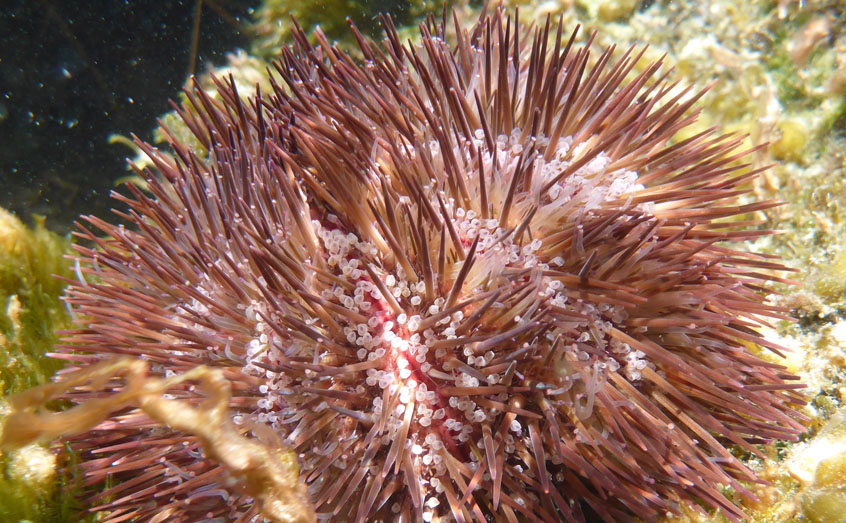SAMS news room
Increased rainfall threatens UK sea urchins

The ‘freshening’ of seawater around the UK through heavier rainfall caused by climate change could spell disaster for sea urchins, a new study has found.
The study, published by scientists from SAMS, British Antarctic Survey and the University of Cambridge, showed how sea urchins exposed to diluted seawater for long periods show signs of physical deterioration.
Their research also found that even slight changes in salinity – or saltiness – trigger changes to urchin behaviour as they try to cope with their new conditions.
Urchins are slow moving bottom feeders, making them especially vulnerable to rapid changes to their habitat. In the UK, climate change is predicted to ‘freshen’ many coastal areas, so the research underscores the potential impact of climate-induced rainfall changes on these marine animals and their broader ecosystems.
As our climate warms, Britain’s weather is becoming more extreme; in Scotland precipitation has increased by 20% since the 1960s. Salinity is one of the critical environmental factors that affect the biology of marine organisms, with increased rainfall and glacial melting reducing the salinity of coastal waters.
In the research aquarium at SAMS, scientists exposed European sea urchins a to conditions mimicking those that could occur under future climate scenarios. Over an initial 24-hour period, and later for 25 days, the team measured how much oxygen the creatures consumed, how quickly they fed and their ability to flip themselves over if they toppled.
In the mid-salinity water, the scientists observed changes in behaviour, but the sea urchins showed clear signs of adjustments and tolerance, indicating they could survive long-term at this level if conditions change in the environment.
But immersed in less salty water the urchins’ physical condition deteriorated: they became sluggish, eating less and breathing more rapidly. They lost spines and body mass, and their tube-feet discoloured, indicating severe stress.
Nicholas Barrett, PhD student at British Antarctic Survey and the Department of Earth Sciences at the University of Cambridge says: “Coastal waters are predicted to freshen as climate changes because of increased rainfall and glacial melting, and salinity is one of the main factors impacting the physiology and ecology of marine life.
“Though it was heartening to see the sea urchins successfully adjust to some reduction in salinity, further reductions had a dramatic impact on the animals health, suggesting their long-term survival could be severely compromised.
“This urchin species plays a crucial role in controlling the growth of various large kelp seaweeds. Its disappearance could therefore upset the delicate balance of coastal ecosystems.”
Controlled salinity experiments like these differ from the natural acclimatisation process that urchins may exhibit in the wild, but this research offers a clear prediction of how this species may fair under future heavy rainfall induced by climate change.
SAMS marine biologist Dr Helena Reinardy said: “We are very interested in understanding how marine organisms cope and adapt to changing conditions and how vulnerable they may be when conditions go beyond their capability to adapt.
“We use our aquarium facilities to mimic changing conditions such as reduced salinity, and our expertise in sea urchin biology and experimental research is perfect for collaborations with other researchers with complementary expertise.
“Sea urchins are found in all the world’s oceans and we use them as models for understanding mechanisms of stress response and adaptation from the genetic and molecular levels up to whole animal welfare and survival.”
